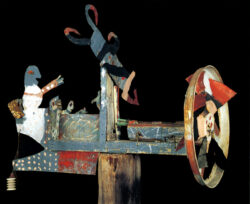David Butler
Well known in for his audaciously decorated home and lawn, David Butler fashioned whimsical, brightly painted assemblages from salvaged roofing tin to become one of the twentieth century's most widely collected self-taught artists.

Courtesy of Dr. Kurt Gitter and Alice Rae Yelen
Whirligig. Butler, David (Artist)
Well known in the town of Patterson, Louisiana, in St. Mary Parish for his audaciously decorated home and lawn, David Butler fashioned whimsical, brightly painted assemblages from salvaged roofing tin to become one of the twentieth century’s best-known and most widely collected self-taught artists. His bestial forms and anthropomorphic shapes, whether mounted as whirligigs in his yard or affixed to the exterior of his house, ranged in size from modestly scaled to several feet tall. Thought by Butler to contain mystical powers, his fanciful cutouts suggest many of the aesthetic and symbolic African retentions observed in other African-American exterior ornamentation of the American South.
Born on October 2, 1898, in the South Louisiana hamlet of Good Hope, David Butler demonstrated an early propensity for art making in the drawings and carvings he made as a child and adolescent. He may have inherited his skill in working with his hands from his father, a carpenter. His strong spirituality and deep respect for religious tradition were instilled in him by his mother, a missionary. These traits, combined with an eye for color and beautiful form, were important in shaping the singular artistic vision that Butler began to manifest later in his life.
Before he began making art, Butler spent much of his adult life working at menial jobs in the timber and pulpwood industry. He was sixty-two years old when a work-related accident left him partially disabled and forced his retirement from full-time wage earning. It was then that he turned to art as a way of passing the time and livening up his home. In this respect he was like many other self-taught artists, who began their creative careers only after becoming disabled or otherwise forcibly retired from more mundane employment.
Working with readily available materials that cost little or nothing, Butler started fashioning lively, kinetic assemblages which he installed on wooden posts around the outside of his house. Using a knife and a hammer, he cut distinctively fanciful silhouettes of animals and humanoid figures from old slabs of roofing tin. He then painted these in bold colors and loose geometric patterns, nailing or otherwise affixing them to scrap-wood supports that had attached movable wheels or propeller blades made of the same cast-off materials. In addition to these freestanding whirligigs, he made decorative scrap-tin cutouts that he nailed over the windows of his house, enhancing his privacy while also creating lively patterns of sunlight and shadow on the interior floors and walls. He reportedly told one friend—the academically trained sculptor John Geldersma—that these window coverings were “spirit shields,” intended to protect him from harm. He evidently believed they could deflect the negative forces to which he felt vulnerable following the death of his wife in the 1960s, only a few years after his disabling accident.
This tends to support some scholars’ suggestions that Butler’s art contains visual and symbolic components rooted in African tradition. In addition to the protective charms that have long been used in western and central Africa, his work also appears to be related to sacred Kongolese cosmograms and grave embellishments, as well as to aspects of Haitian popular art and Vodun (voodoo) religion that are similarly derived from African sources.
A number of professional artists and other individuals involved in the contemporary art world learned of Butler’s art and began visiting him in the 1970s, just as the work of self-taught artists was beginning to attract a mass audience. His work first drew national attention when several of his painted assemblages were included in Black Folk Art in America, 1930-1980, a twenty-artist traveling exhibition organized by the Corcoran Gallery of Art in Washington, D.C. Largely as a result of this show, art collectors began buying what work Butler was willing to part with, but he was ambivalent about selling pieces he had made for his own use and amusement. “I can make things because God gave me a gift,” he said in 1983. “But God don’t want no one selling what’s a gift. If you have a gift, then you shouldn’t be taking no money.”
Butler continued to produce and occasionally sell new work for a few more years, but beginning in the mid-1980s, repeated incidents of vandalism and increasing crime in his neighborhood left him discouraged and fearful, and he stopped making art altogether. These problems, combined with his declining health, eventually led him to move out of his house. After living with relatives for a while, he entered a nursing home in Morgan City, Louisiana. Butler died there in his sleep on May 16, 1997, just short of his ninety-ninth birthday.
